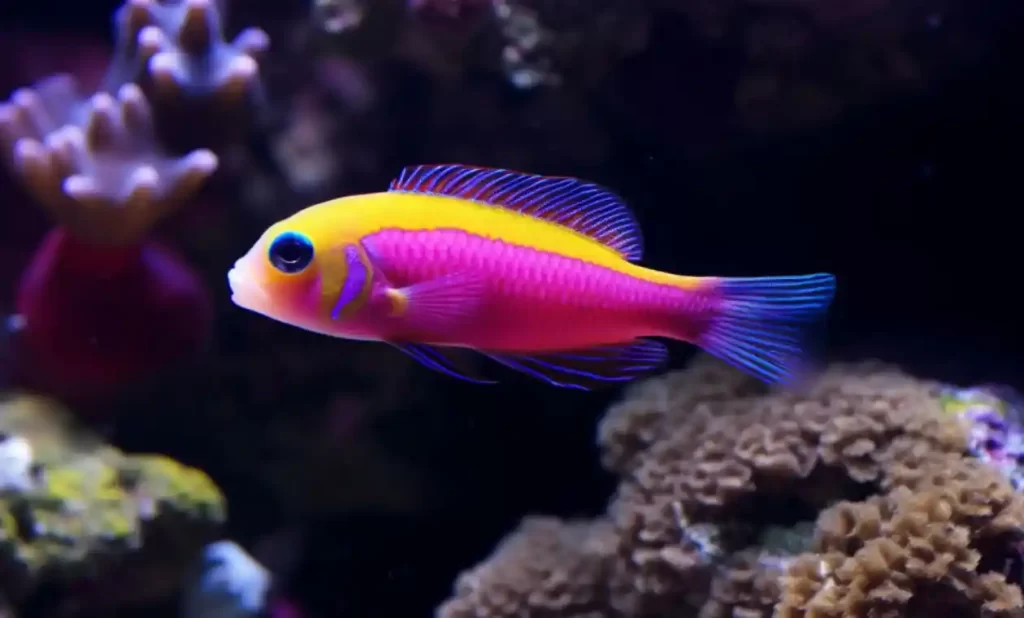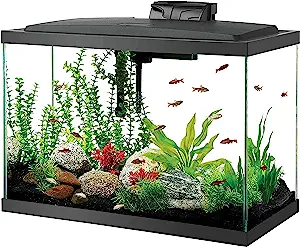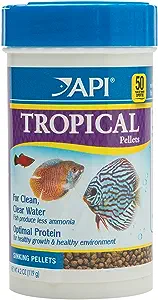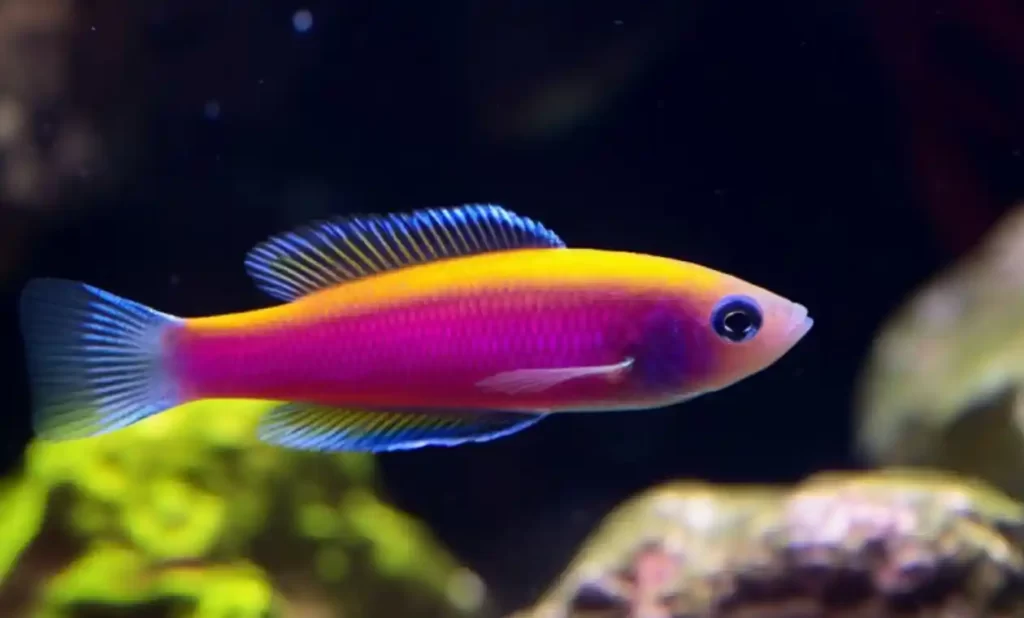Dottybacks: The Vibrant Rulers of the Reef

Imagine being a vibrant, enigmatic creature, ruling the vibrant reefs with flamboyance and a touch of aggression – welcome to the world of Dottyback fish!
Hello dear readers, today we’re embarking on a fantastic underwater journey where you’ll meet one of the most vibrant and fascinating creatures of the marine world – the Dottyback fish. Picture a fish that combines the grace of a dancer with the boldness of a warrior. In the colorful underwater jungles, amidst the waving seaweed and vibrant corals, resides our flamboyant star – the Dottyback.
Imagine a creature so vivid, so full of life, darting between coral branches with agility and grace. Its colors are a live painting, an ever-changing canvas that adapts and transforms according to its surroundings and moods. This is no ordinary fish, dear aqua enthusiasts. It’s a spectacle of the sea, a testament to the wonders that lie beneath the waves.
Join us as we don the hat of an Aqua Scientist, delving deep into the mysterious and vibrant world of Dottyback fish. Whether you are a seasoned aquarist or a curious newbie, this guide will help you understand these colorful creatures better. So grab your virtual snorkel and fins, as we dive into the shimmering waters to explore the lively, and somewhat feisty, world of the Dottyback fish.
Stay with us as we unveil the secrets of their vibrant lives, their habitats, their behaviors, and much more. In the simplest terms, let us whisk you away on a journey where you’ll learn everything there is to know about these vivid wonders of the deep blue sea.
Meet the Dottybacks
Identification
What comes to your mind when you hear the term “Dottyback fish”? Perhaps, a dash of vibrant colors or a spirited, flamboyant swimmer darting through the nooks and crannies of a reef? Well, you’re not too far from the truth!
Dottyback fish are small, vibrant marine fish that belong to the family Pseudochromidae. Their vivacious colors and dynamic personalities make them a captivating sight in any marine aquarium. These captivating creatures are known for their slender bodies adorned with brilliant hues that can range from yellows, pinks, to deep purples, often changing throughout their lifetime. Their distinctive, bright colors and patterns not only make them a visual treat but also facilitate a fascinating method of communication and camouflage in their natural habitat.
Different Species of Dottyback Fish and How to Identify Them
In the vibrant family of Dottyback fish, you can find an array of species each with its unique characteristics and charm. Let’s meet some of the popular species and learn how to identify them:
1. Orchid Dottyback (Pseudochromis fridmani):
Appearance: The Orchid Dottyback boasts a bright purple or lavender body that easily grabs attention. Its elongated body paired with its vibrant hue makes it a mesmerizing addition to any marine aquarium.
Habitat & Distribution: Originally found in the Red Sea, this species prefers coral-rich environments where it can easily find shelter and nourishment.
Diet: This omnivorous species has a varied diet consisting mainly of small crustaceans, zooplankton, and marine algae. Providing them with a balanced diet in captivity helps in maintaining their vibrant coloration.
Aquarium Care: In the aquarium, they require plenty of hiding spots created using rocks and corals. Despite their beauty, they have a somewhat aggressive nature, so careful consideration is needed when choosing tank mates.
Breeding: They are known to breed quite well in captivity, with males establishing territories and courting females during breeding seasons.
2. Royal Dottyback (Pseudochromis paccagnellae):
Appearance: The Royal Dottyback is easily recognizable by its strikingly contrasting colors. The anterior half of its body is bright purple while the posterior half is vibrant yellow, creating a splendid display of color in the aquatic environment.
Habitat & Distribution: Native to the Indo-Pacific region, they typically inhabit coral reefs and lagoon areas where they have easy access to food and shelter.
Diet: Their diet primarily includes small invertebrates, zooplankton, and occasionally, marine algae. Feeding them a variety of foods ensures they receive all the necessary nutrients.
Aquarium Care: Like other Dottybacks, they need well-structured aquariums with hiding spots. They can be somewhat territorial and aggressive, especially towards similar-looking species.
Breeding: Breeding in captivity is possible, with males displaying territorial behaviors and females laying eggs in hidden crevices.
3. Strawberry Dottyback (Pseudochromis porphyreus):
Appearance: This species is adorned with a gorgeous pink to red hue, resembling a ripe strawberry, thus the name. Their vibrant color makes them a focal point in any marine aquarium.
Habitat & Distribution: These fish are commonly found in the Western Pacific, mainly around the regions of Indonesia and the Philippines, residing in coral-rich environments.
Diet: They primarily feed on small crustaceans and zooplankton. In captivity, a balanced diet of marine pellets, flakes, and frozen foods can be provided.
Aquarium Care: A well-set aquarium with numerous hiding spots is ideal for this species. Be wary of their aggressive tendencies when pairing with other fish.
Breeding: Although not extensively documented, they are believed to exhibit similar breeding behaviors to other Dottyback species, with males guarding territories and attracting females for breeding.
4. Neon Dottyback (Pseudochromis aldabraensis):
Appearance: True to its name, the Neon Dottyback showcases neon blue or green hues that dazzle and add a splash of vibrant color to aquarium setups.
Habitat & Distribution: This species is generally found in the Western Indian Ocean, particularly around the Aldabra Atoll, preferring coral reefs rich in crevices and hiding spots.
Diet: They are carnivorous, primarily feeding on small invertebrates and zooplankton found in their natural habitat.
Aquarium Care: To mimic their natural habitat, set up a well-planted aquarium with rocks and crevices that allow them to hide and explore. Despite their stunning appearance, they are known for their aggressive behavior, necessitating careful selection of tank mates.
Breeding: Similar to other Dottybacks, the Neon Dottyback exhibits territorial behavior during breeding, with males attracting females and guarding their territories fiercely.
When identifying Dottyback fish, it’s essential to look at not only their color but also their body shape, size, and patterns. It’s like being a fish detective, where each clue brings you closer to identifying the species accurately.
Natural Habitat
Now, let’s venture into the natural realms where these vivid beings reside. The Dottyback fish habitat is as diverse as their color palette. Generally found in the warm, shallow waters of the Indo-Pacific region, these fishes prefer to stay close to coral reefs and rocky crevices, where they can easily hide from predators and hunt for prey.
Their habitats are a riot of colors, with corals of different shapes and sizes offering shelter and sustenance. In these vibrant underwater gardens, Dottyback fish navigate skillfully, exhibiting a marvelous blend of flamboyance and survival tactics.
In their natural settings, Dottyback fish lead a somewhat solitary life, marking their territories amidst the corals and being quite protective of it. It’s a realm where vibrancy meets vitality, offering a glimpse into the dynamic life cycles present beneath the ocean’s surface.
Dietary Habits
In our exploration as Aqua Scientists, it’s essential to understand what fuels these vibrant beings in their natural habitat. Let’s take a closer look at the culinary preferences of the Dottyback fish.
Dottybacks are not too fussy when it comes to their diet. Being carnivorous by nature, their diet mainly consists of small crustaceans, such as copepods and amphipods, and various types of marine worms. Their sharp, protruding teeth are perfectly adapted for nabbing swift and elusive prey, offering them a banquet of flavors from the underwater world.
When in an aquarium, their dietary habits can be catered to by offering them a variety of high-quality marine foods like brine shrimp, mysis shrimp, and other meaty treats. As an Aqua Scientist, it would be your job to ensure that these voracious eaters have a balanced diet that keeps them healthy and vibrant.
Behavioral Traits
Dive a little deeper, and you’ll find that the Dottybacks are as complex in their behaviors as they are in their colors. In the wild, these fish are known for their territorial and sometimes aggressive nature. They establish individual territories within the reef, fiercely guarding it against intruders.
But don’t let their aggressive streak fool you. These fish are intelligent and adaptive, capable of changing their color to blend with their surroundings, a phenomenon known as mimetic behavior. This behavior not only helps in evading predators but also in cunningly approaching their prey.
In a community aquarium setting, their temperament can be a double-edged sword. While their vibrant personalities can add a dash of excitement to your tank, their aggressive tendencies might need to be kept in check to ensure harmony in the aquatic community.
Morphological Features
To truly appreciate the beauty of the Dottyback fish, one needs to delve into their morphological characteristics. These fishes are generally small, with most species measuring between 3 to 4 inches in length, although some can reach up to 7 inches. Here, we unfold the secrets behind the varied “Dottyback fish size” and patterns that grace these aquatic canvases.
Their slender, elongated bodies are designed for quick, darting movements, allowing them to navigate through the intricate structures of the reef with ease. Moreover, their vivid hues are not just for show; they play a vital role in their survival, helping them communicate and defend their territories effectively.
Their expressive eyes, coupled with their vibrant coloration, offer an insight into a world that thrives on flamboyance and survival instincts, making them one of the most fascinating subjects for any Aqua Scientist.
Bringing Dottyback Fish to Your Aquarium


Transforming a part of your living space into a mini-oceanic haven can be a rewarding experience, especially when you’re planning to host the vibrant Dottyback fish. But first, let’s chat about the ideal setup for a Dottyback fish tank.
The general rule of thumb is to have a tank that can hold at least 30 gallons of water, which provides ample space for these territorial fish to stake out their domains without causing too much friction. The setup should mimic their natural habitat as closely as possible with plenty of rocks and corals that offer hiding spaces for them to retreat and feel safe.
An essential aspect of the setup is water quality. Make sure to maintain pristine water conditions with stable temperature and pH levels to ensure their vibrant hues and healthy life. Proper filtration and regular water changes are non-negotiable to recreate the perfect oceanic abode.
Compatibility with Tank Mates
When it comes to finding the right neighbors for your Dottyback fish in the aquatic setup, caution is advised. Due to their territorial and somewhat aggressive nature, Dottyback fish are best housed with species that can hold their own. Avoid keeping them with timid or slow-moving fish, as they may fall victim to the Dottyback’s assertive behavior.
Ideal tank mates might include other semi-aggressive species such as larger damselfish, angelfish, or wrasses. It’s always best to do a bit of research or consult with an aquarist expert to ensure a peaceful and harmonious community within your tank.
Care Guide
Now that we’ve set the stage, let’s turn our attention to the day-to-day care that these flamboyant beings require. Here, we unveil the ultimate Dottyback fish care guide that goes beyond just feeding and maintenance.


- Diet: As discussed earlier, these carnivorous fish enjoy a diet rich in protein. Ensure to offer a variety of marine-based foods to keep them healthy and their colors vibrant.
- Habitat: Create a stimulating environment with plenty of hiding spots and room to explore, helping to keep their aggressive tendencies in check.
- Prevention of Diseases: Keeping a keen eye on your Dottybacks and ensuring a clean environment can prevent most diseases. If you notice any signs of illness, quarantine the affected fish immediately to prevent the spread of disease in the tank.
- Breeding: If you plan on breeding, ensure to create a conducive environment with plenty of hiding spots and a balanced male to female ratio to avoid conflicts.
Fascinating Facts
Color Changing Abilities
As we continue our venture into the vivid world of Dottyback fish, we stumble upon one of their most fascinating attributes – their ability to change color, almost like chameleons of the sea. This color transformation isn’t merely a spectacle but a sophisticated survival technique.
Dottybacks have special cells in their skin called chromatophores that contain pigments. These cells can expand or contract, allowing the fish to alter their color in a flash, adapting to different environments and deceiving predators or prey. This mesmerizing ability is not only a testament to their adaptability but also a window into the incredible world of marine biology. Let’s embrace the wonder of nature as we decode the science behind this color-changing phenomenon, showcasing the sheer marvel that is the Dottyback fish.
Breeding Habits
Breeding Dottybacks can be akin to witnessing a vibrant dance unfold in your aquarium. But before we dive into the intricacies of breeding, understanding how to differentiate between males and females becomes vital.
Males are generally larger and exhibit more vibrant colors compared to females. During breeding seasons, these differences become more pronounced, as males flaunt brighter hues to attract potential mates. The breeding process itself is quite unique, with the males taking on the responsibility of guarding the eggs until they hatch.
As an Aqua Scientist, fostering a conducive environment for breeding can be a rewarding venture, where you get to witness the birth and growth of these vibrant beings, thus contributing to the preservation and proliferation of this fascinating species.
Life Span
Embarking on the journey of understanding the Dottyback fish lifespan unveils a saga of growth and evolution. Typically, Dottybacks enjoy a lifespan of 5 to 7 years, although with optimum care and a well-maintained habitat, they can live even longer.
Their journey from fry to adult is a sight to behold. As fry, they are tiny, delicate beings, embarking on a journey of growth and exploration. With time, they transform into vibrant adults, exhibiting the flamboyant hues and spirited personality that Dottybacks are known for. Observing their life cycle provides a glimpse into the vibrant and dynamic world that exists beneath the ocean waves, right in the comfort of your home.
Conclusion
And there we are, at the end of our vibrant voyage into the enthralling world of Dottyback fish. These remarkable creatures captivate not only with their flamboyant hues but also with their spirited personalities and intriguing behavioral traits. From their fascinating morphological features to their remarkable ability to change colors, Dottyback fish embody the vibrant and dynamic life that thrives beneath the ocean waves.
Their intelligence, coupled with their slightly assertive demeanor, makes them a popular choice among aquarium enthusiasts, offering a slice of the vibrant ocean life right within the confines of their homes. As Aqua Scientists, we have the privilege to observe, nurture, and be a part of their colorful journey from fry to flamboyant adults, a journey that is marked by growth, transformation, and a splash of drama.
Now, it’s your turn to dive in and become a part of this vibrant world. We would absolutely love to hear about your own experiences with these fascinating beings. Perhaps, you are considering welcoming a Dottyback into your aquatic family? Remember, embarking on this journey not only brings color and life into your living space but also offers you a front-row seat to witness the marvels of marine life.
So, dear readers, are you ready to bring a splash of color and a dash of flamboyance to your aquarium? Share your thoughts, experiences, or plans in the comments below, and let’s foster a community where we can share and learn from each other’s adventures in the aquatic world.
Buying Guide
Before you set out to bring a Dottyback fish home, it’s essential to know where to buy and what to look for to ensure you are getting a healthy and vibrant specimen.
- Certified Breeders and Retailers: Always opt for certified breeders or retailers who are known for their quality and ethical practices. They should be able to provide you with detailed information about the fish’s origin, health, and care requirements.
- Physical Examination: When purchasing, look for active fish with vibrant colors, clear eyes, and no signs of injury or disease. Avoid fish that are lethargic or have dull colors, as they might be unhealthy.
- Adaptive Species: Since there are various species of Dottyback fish, choose one that adapts well to aquarium life. Consult with the retailer or an expert to find the best match for your tank.
Further Reading
To further quench your thirst for knowledge, we recommend delving into these informative resources:
- Books:
- “Marine Fishes: 500+ Essential-To-Know Aquarium Species” by Scott W. Michael
- “PocketExpert Guide: Marine Fishes” by Scott W. Michael
- Journals:
- Journal of Fish Biology: For scholarly articles and latest research findings on different fish species including Dottybacks.
- Aquarium Sciences and Conservation: A journal that covers various aspects of aquarium fish care, including studies on Dottyback fish.
- Websites:
- Reef2Reef: A popular forum where you can interact with other aquarium enthusiasts and experts.
- Saltwater Aquarium Blog: A treasure trove of articles and guides on marine aquarium setup and care.
With these resources at your disposal, you are all set to begin or continue your journey into the wonderful world of Dottybacks, equipped with knowledge and the excitement of discovery.
Dottybacks FAQ
Are Dottyback fish aggressive?
Yes, Dottyback fish are known for their aggressive behavior, particularly towards other fish of the same species or those inhabiting the same niche in the aquarium. It is advisable to keep them with fish that can stand up to their assertive nature to maintain a peaceful aquarium environment.
How to identify various species of Dottyback fish?
Identifying different species involves observing their coloration, patterns, and body shapes. For example, the Orchid Dottyback is recognizable by its bright purple hue, while the Striped Dottyback sports distinct black and white stripes. It is beneficial to consult a comprehensive guide or an expert for precise identification.
Are there any specific diseases that affect Dottyback fish?
Like many other aquarium fish, Dottybacks are susceptible to common marine fish diseases such as Ich, Marine Velvet, and bacterial infections. Implementing a regular monitoring and maintenance routine can help prevent these diseases and ensure the wellbeing of your fish.
What research has been done on Dottyback fish behavior and physiology?
Research on Dottyback fish primarily focuses on their aggressive behavior, color-changing abilities, and their role in the coral reef ecosystem. Scholars and marine biologists conduct studies to understand their interaction with the environment and other species. For detailed research articles, you might want to explore scientific journals and marine biology databases.

